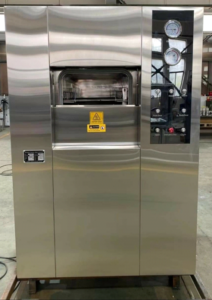A horizontal rectangular front-loading autoclave is a type of sterilization equipment commonly used in medical, research, and laboratory settings. It is designed to sterilize various items, such as laboratory glassware, instruments, and other heat-resistant materials.

Here are some key features and characteristics of a horizontal rectangular front-loading autoclave:
Design: As the name suggests, this autoclave has a rectangular chamber, which is horizontally positioned. The front-loading design allows for easy loading and unloading of items.
Sterilization Principle: The autoclave uses high-pressure saturated steam to achieve sterilization. Steam is generated by heating water in a separate chamber and then injected into the main sterilization chamber. The high temperature and pressure effectively kill microorganisms and spores on the items being sterilized.
Control System: The autoclave is equipped with a control system that allows the operator to set and monitor the sterilization parameters. This typically includes the ability to control temperature, pressure, and sterilization time. The control system ensures that the sterilization process meets the required standards.
Safety Features: Autoclaves have built-in safety features to protect the operator and prevent accidents. These may include pressure relief valves, door interlocks to prevent opening when the chamber is pressurized, and alarms or indicators for temperature and pressure deviations.
Capacity: Horizontal rectangular front-loading autoclaves come in various sizes and capacities to accommodate different sterilization needs. The chamber size can range from small tabletop models suitable for small laboratories to larger units capable of handling bulk sterilization.
Construction: Autoclaves are typically made of stainless steel, which is resistant to heat and corrosion. The chamber is well-insulated to maintain the desired temperature and pressure during sterilization.
Accessories: Autoclaves may come with various accessories to support the sterilization process. This can include trays, racks, and baskets to hold the items being sterilized, as well as water tanks, filters, and drainage systems.
Validation and Documentation: Autoclaves often have features to validate and document the sterilization process. This can include data logging capabilities, integrated printers, and software for generating sterilization reports.
It’s important to note that specific models and manufacturers may have variations in design and features. Always consult the manufacturer’s instructions and guidelines for proper operation and maintenance of a horizontal rectangular front-loading autoclave.
Horizontal rectangular front-loading autoclaves offer several benefits in sterilization processes.

Here are some key advantages:
Ease of Loading and Unloading: The front-loading design allows for easy access to the sterilization chamber. Items can be conveniently placed and removed without the need to reach into the autoclave or maneuver them through a top-loading or vertical chamber. This enhances operational efficiency and reduces the risk of handling accidents.
Space Efficiency: The horizontal rectangular shape of the autoclave optimizes space utilization. It can fit into tight laboratory or medical facility layouts more efficiently than other autoclave designs, such as vertical models. This is particularly advantageous for facilities with limited space.
Versatile Application: Horizontal rectangular front-loading autoclaves can accommodate a wide range of items for sterilization. They are suitable for sterilizing laboratory glassware, instruments, containers, and other heat-resistant materials. The size and capacity options available make them versatile enough to handle both small and large batches of items.
Improved Visibility: With the front-loading configuration, operators have better visibility into the sterilization chamber. This allows them to monitor the process more effectively, ensuring that the items are properly placed and that there are no obstructions or issues during the sterilization cycle.
Enhanced Safety Features: Front-loading autoclaves often come with robust safety features to protect the operator and the equipment. These can include interlocks that prevent opening the chamber while it is pressurized, alarms for abnormal conditions, and emergency pressure relief valves to prevent over-pressurization.
Precise Control and Monitoring: Modern horizontal rectangular front-loading autoclaves are equipped with advanced control systems that enable precise control and monitoring of sterilization parameters. Operators can set and adjust temperature, pressure, and cycle times according to specific sterilization requirements, ensuring effective and reliable sterilization.
Validation and Documentation Capabilities: Autoclaves with built-in validation and documentation features provide an advantage in regulated environments. These capabilities allow for the collection of data and generation of sterilization reports, aiding in compliance with regulatory standards and quality control processes.
Durability and Ease of Maintenance: Autoclaves are typically constructed with durable materials such as stainless steel, ensuring longevity and resistance to heat and corrosion. Additionally, their design facilitates easy cleaning and maintenance, which is crucial for consistent performance and extended equipment life.
It’s important to consider specific requirements and application needs when selecting an autoclave. Manufacturers may offer additional features and customization options to meet specific industry or user demands.





